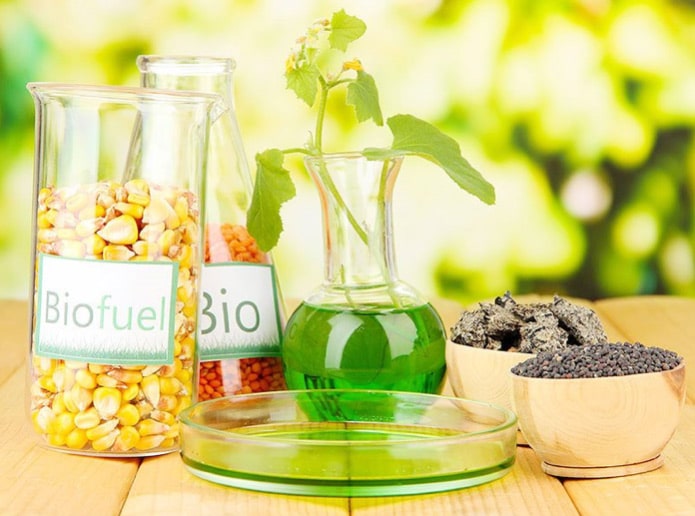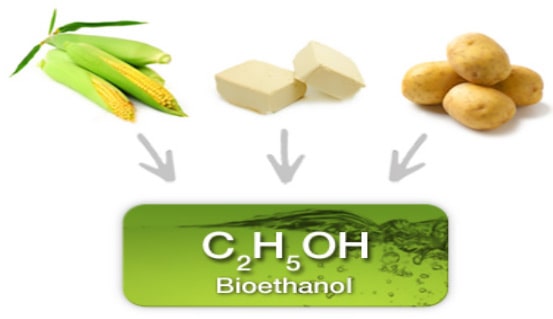
Most frequent vegetable oils are : rape seed oil (most productive culture), then sunflower oil, and soybean oil.
In the past few years, researchers and Engineers have developed technologies of production of biodiesels. Raw materials employed for these productions are soybeans, canola, sunflower, corn, peanuts, sesame and many other fast-growing cereals, whose biomass is fermented with chemicals or bacteria and transformed into ethanol and other types of alcohols.

Biodiesel is a biofuel having consumer properties similar to diesel. For production purposes, we can also employ oils which cannot be used for any reason for human nutrition.
The principle of processing is to conduct a chemical reaction of vegetable oils or fats of biological origin with methanol or alkali at elevated temperatures, followed by filtration to obtain biodiesel. The main advantage of biodiesel is that it is produced from resources that are quickly restored. Today, biodiesel is the main breakthrough in the field of alternative fuels.
It is safe, harmless, effective and clean. When released into the water, it does not harm the aquatic flora and fauna. When using biodiesel on river and sea vessels, it is possible to substantially minimize pollution of the planet’s water resources. It is quite simple to prepare and use, which cannot be said about other fuels. The production of biodiesel in the world is increasing every year. In Europe, the leader in biodiesel production is Germany.
Vegetable oils, as fuel, are characterized by higher energy density in comparison with alcohols, but their performance is worse than that of alcohols. In particular, a significant drawback is the high viscosity and a large tendency to the formation of soot. Therefore, it is preferable to use vegetable oils in a mixture with diesel fuel. A mixture of oil with a diesel engine is called a biodiesel mixture or biodite.

Bioethanol — is the most common biofuel of those that are produced industrially. Every year the world produces over 70 million tons of this plant-based fuel, and its production volumes increase every year. Most often, bioethanol is used as a component of various motor oils. USA today produces about a third of gasoline with a content of bioethanol. Its use significantly reduces the level of toxicity of exhaust gases.
Biodiesel, from a biological point of view, is a harmless fuel. Experts believe that it could be more actively used as fuel for sea and river vessels — getting into the water, biodiesel does not cause damage to the flora and fauna of the oceans, seas and rivers. The fuel in this environment almost completely disintegrates (up to 99% in a month) — there is a minimization of pollution of the Earth’s water resources.
In many countries (for example, USA and Brazil), bioethanol production is encouraged by national programs, and such economic agents are subsidized and enjoy tax benefits. In America, they are gradually moving away from the production of bioethanol from grain raw materials, with an emphasis on cellulosic sources (wood).
Sugar or starch is the basis for the production of the first generation butyl alcohol (butanol). Plant cellulose is used as a raw material for the manufacture of second generation biobutanol. Basically, biobutanol is used today as an industrial solvent. Most of it is produced by America (over 200 million gallons of the 350-millionth volume of the world market).
Some time ago, researchers of biofuel properties found that biobutanol would be more effective in using motor oil as a component than bioethanol — this fuel has a low vapor pressure and therefore it is easily mixed with gasoline. Biobutanol is more transportable — it can be supplied using pipelines, whereas special tanks or river (sea) tankers are required to transport bioethanol. The problem is high energy consumption in the production of biobutanol. But experts have already conducted a number of successful experiments, which allowed to significantly increase the yield of fuel in the production process.
Biodiesel in Germany is cheaper than diesel
The original component of another type of biofuel — biodiesel — oil of rapeseed, soybean, palm, sunflower, flax and other oil-bearing plants. Modern Western scientists are developing technologies for the production of biodiesel using genetically modified organisms, as well as algae. EU countries consider biodiesel as the main renewable liquid biofuel. According to analysts, global production will reach 100 million tons per year by 2020 at a sustained rate. The European leader in the production of biodiesel is Germany. The share of their production accounts for up to 5 million tons of fuel annually. Besides the Germans have biofuels cheaper diesel fuel: its production subsidizes the federal budget.

In the US, biodiesel is made mainly from soybean oil. Soybean as a raw material accounts for about a third of the global biodiesel production, the rest is rapeseed and palm oil. There is a constant process of finding cheaper raw materials — they already use jatropha, camelina, castor oil for the manufacture of biodiesel ... But the so-called bio-oil is a vegetable fuel and contains alcohols and other components, but not hydrocarbons, so the name «bio-oil» is quite arbitrary. The substance is produced by oxygen-free heating of raw materials (it can be wood chips or molasses bard — sugar refining waste).
In the future, use as a raw material for the production of bio-oil of various kinds of household waste, at the exit giving a product that is not inferior in its properties to genuine natural oil. Over such a project, in particular, the US Department of Energy is actively working today.
As a raw material — any biomass
As a motor fuel, vegetable oils have been used in the world for a long time. Most often rape seed oil is used — this culture is the most productive. On the second place from vegetable oils on frequency of use is sunflower oil, on the third — soybean. A new promising source of raw materials is algae: they contain up to 40% of the oils from the total mass, and they are more productive than the «terrestrial» plants.
The world leader in the use of vegetable oils (often from rapeseed) as a motor fuel is Germany. Americans prefer to use soybean oil as a biofuel. Vegetable oils are energetically denser than alcohols, but more viscous, and therefore it is better to mix them with diesel fuel. This mixture is called biodite.
Biofuel-to-Liquid (BTL) is considered an innovative, most modern and most promising technology with which it produces liquid biofuels. BTL began to be used only at the beginning of the XXI century, such concerns as Shell, Daimler, Volkswagen took part in its development.

Almost any solid biomass can be taken as a raw material — wood chips, straw, waste of the agro-industrial complex ... In the process of biofuel production in a similar way low-temperature pyrolysis (oxygen-free heating) is used. According to experts, in the future, the resulting liquid as a result of this and the operations following it can completely replace the fuel that modern cars drive today. This is proved by the experiments conducted in the Volkswagen concern.
The new fuel in comparison with gasoline is half the emissions to the atmosphere. However, while the production of BTL is more expensive than the production of diesel fuel. But scientists are convinced that this is a temporary problem — it is enough just to improve the technology.

